
I like visual novels. It’s a great genre that’s only picking up speed in North America, but is still widely ignored by the mainstream. Much like manga and anime, visual novels are a genre that the West has been slow to adopt but will likely eventually add to the lexicon of Japanese inspired media fervently adored worldwide. There are plenty of us otaku around that love Japanese culture and Japanese-inspired media and games, and as releases are increasingly common to localize, we’re seeing more and more niche titles arriving for Western audiences. Sometimes they’re big epic things like Steins; Gate, Lone Wolf & Cub, Akira, or Attack On Titan, but other times they’re small, timely slice-of-life stories that tug at the heartstrings and give insight into the people around us. It’s that latter category that we’re looking at today.

The Language of Love, from Ebi-Hime and publisher Ratalaika Games is a pure visual novel with no interactivity. This sets it apart from other titles in the genre that typically allow for personal choice and branching story elements to provide replay value to their offerings. Instead, we’re treated to a pure voyeuristic approach where we simply read the story as it’s presented. Taking this approach requires a significantly more robust writing style to capture the essence of the characters and create a bond with the reader. It’s more challenging to write and honestly, not the type of story that would normally appeal to most gamers, myself included. If I saw this plot synopsis on the back of a novel, I’d stick it back on the shelf. I don’t read stuff like this. But I’m a fan of the genre and visual novels tend to lend themselves better to this softer type of storytelling than traditional books, especially if they’re outside your normal reading fare. So I gave The Language of Love a shot. And man, am I glad I did!
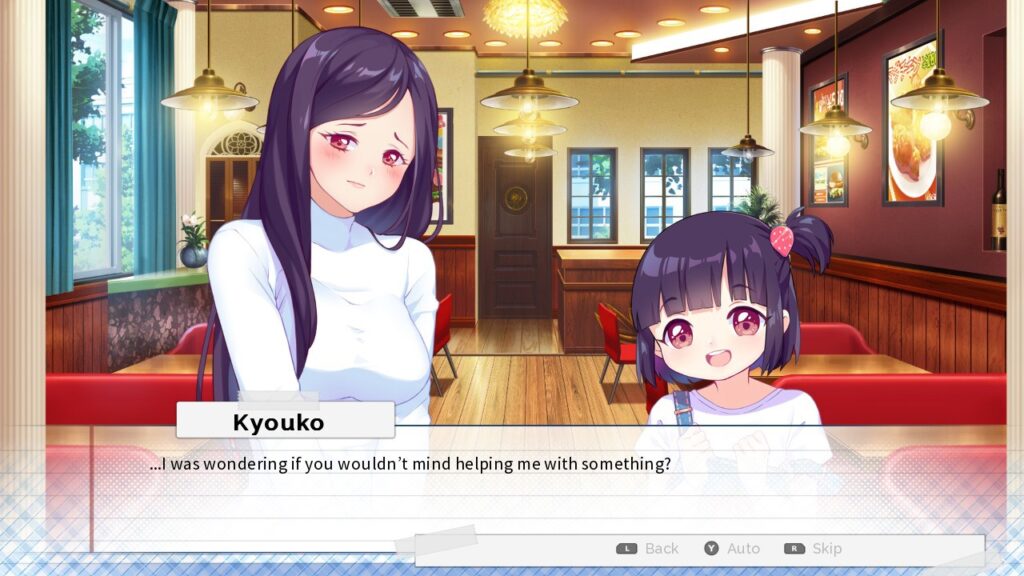
The Language of Love features a young college age Japanese student named Tanimura Mitsuki. This also happens to be the name of a somewhat well-known Japanese actress (a real one, mind you!). Mitsuki is behind a few years in his studies due to issues at home and has left for the big city, alone, to try to find his way in the world while attending cram school to get his career path back on track. Mitsuki could be any university student anywhere who’s in his early 20s. He’s a bit insecure, a bit shy, and worried about his social standing with kids around him who are perhaps younger and more successful. He’s a post-teen with incredibly normal issues and he’s easy to identify with. Anyone who’s ever had a second thought about their choices in life can understand where he’s coming from, even if they’ve never been in the situation and that’s the beauty of the character and the writing. The casual elegance with which the slightly too nervous Mitsuki is written is bordering on literature. He’s lonely, unsure, and worried about his prospects and you can literally feel it.

As the story unfolds, Mitsuki, through an act of kindness, encounters a single mother named Himuro Kyouko and her daughter Tama. Kyouko has had a rough go of things as well, and she’s ended up in the same apartment complex as Mitsuki. She’s lonely, flawed, and struggling to make ends meet. On top of that, the demands of Japanese society are against her as a single mother. If you’re thinking at this point that this sounds like a Hallmark movie, well, you’re not entirely wrong. But it’s on a whole different level and not simply a throwaway plot with cliché lines. As Mitsuki, Kyouko, and Tama slowly get to know one another, the relationship between Mitsuki and Kyouko blossoms from a casual acquaintance into a full-blown relationship step by step, much like many real ones.
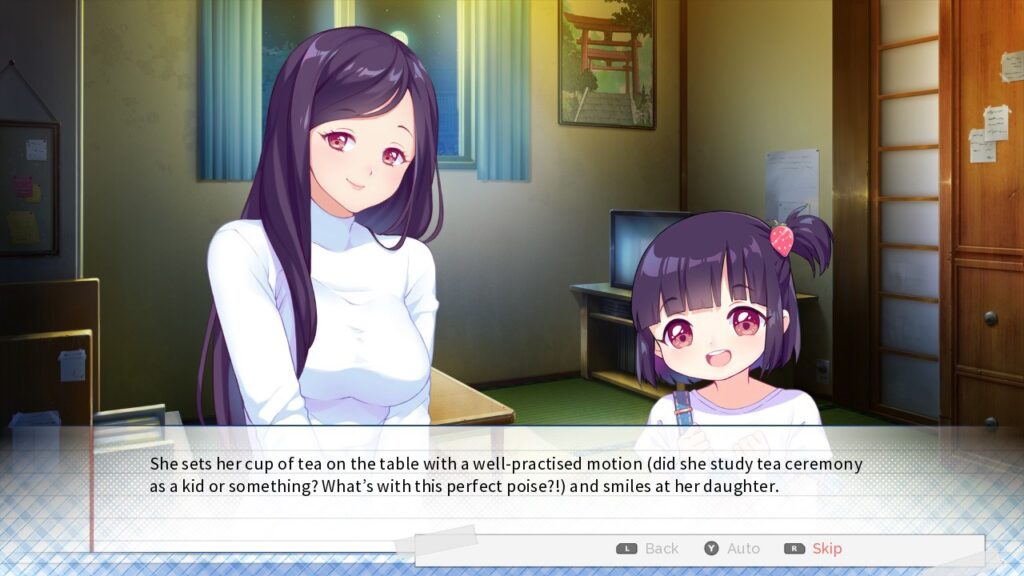
That’s the amazing thing about The Language of Love. Sure, it’s a story. Sure it’s a bit predictable. But none of that matters. This is a visual novel that introduces tiny bits of Japanese culture all through its narrative, teaching the reader about various foods, traditions, social norms, and the consequences of those norms. It’s a snapshot into the culture of Japan and at the same time it’s a masterpiece of subtle relationship building, showing the way that we as humans come to understand each other and grow together while forming into a couple.

Ebi-Hime has a skill with words that I’ve rarely seen, managing to make small remarks and subtle character flaws weave an emotional tapestry that will have almost anyone hooked. That’s not to say that this is a fluffy, happy story all the way through either. It certainly isn’t, and focuses more than a bit on some uncomfortable topic matter before it eventually winds its way into some somewhat more sexually charged territory. However, even this is tactfully managed, and ends up feeling natural and comfortable, rather than forced and perverse. The Switch version of the game is censored and does not show nudity, unlike the original PC release, earning it a T for Teen rating. Honestly though, there’s no need to see Kyouko naked in this story and it’s probably better this way.

But that’s enough gushing about the story, and I’m not going to ruin the plot for you because the tiny incrementally satisfying scenes are what make the game. Instead, let’s take a look at the mechanics. The Language of Love is a simple game. Press a button, advance the story. Use the L button to go back if you missed a sentence or accidentally pressed the button too fast. Use R to move forward all the way to where you’ve left off instantly if you went back a ways. That’s about it. You can speed through the dialogue setting it to high speed auto progression if you lost your save or something, but there’s not much use for that. However, there is one function that’s absolutely essential on the Switch that is included and that’s touch screen compatibility. For the number of visual novels coming out on the Switch now, it’s ridiculous how many of them do not incorporate tactile interfaces. Sometimes I just want to tap the screen to advance it. Most higher end visual novels have this, but strangely, it’s left out of a fair number. Notably, Steins; Gate Zero for the Switch lacks this function, even though it was included in the Vita release and both systems have touch screens. Laying in bed playing a game like this, especially when your spouse is trying to sleep and you’re constantly hitting the A button is irritating at best and this is an incredibly useful function!
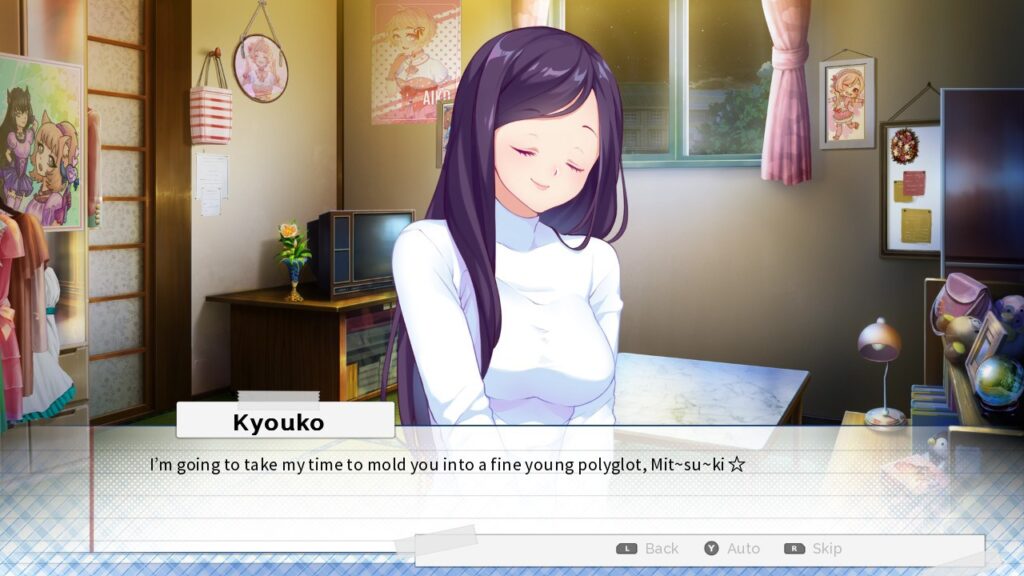
Aside from the interface, visually, The Language of Love isn’t particularly complex either. The animation is limited, the camera angles aren’t innovative like the recent and much lauded Necrobarista (which I reviewed here), and the imagery feels essentially static. When the camera pans, it’s generally panning on an image from top to bottom and the characters barely move, though they do have revealing facial expressions at least. The art style itself isn’t the fanciest I’ve ever seen in a visual novel, but it’s perfectly serviceable and pleasantly less sexual overall than many. This doesn’t feel like a story tacked on to justify t he cheesecake, but instead the artwork lends credence to the characters in the story that more revealing and ridiculous outfits common to the genre wouldn’t manage.
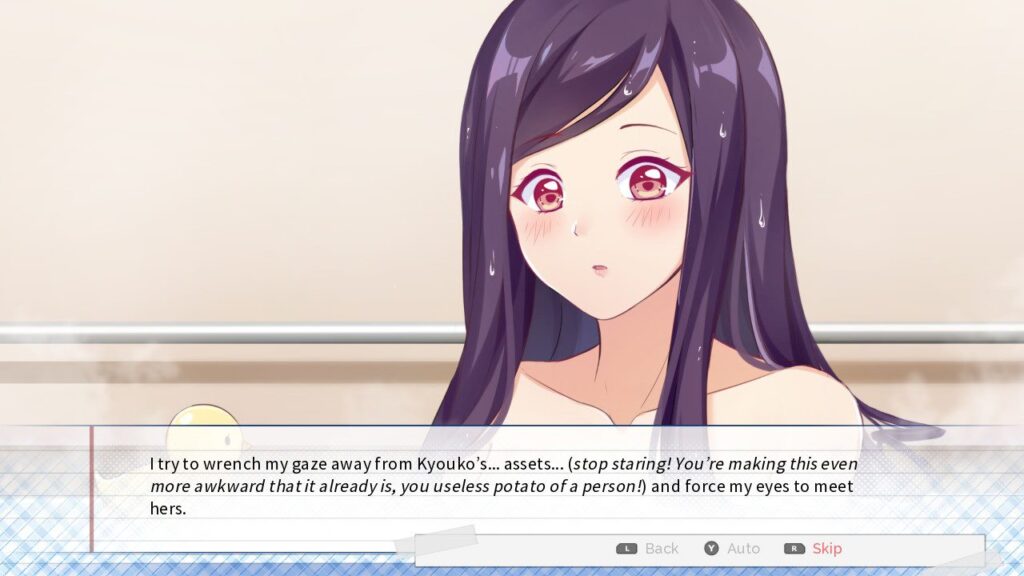
Ultimately, The Language of Love is a love story that shows the slow coming together of two lonely people in different situations, both isolated and hoping for companionship, and it does so in a heart-achingly well-written and lovely way. It’s a solid read and a great story, and while the lack of interactivity calls into question the very nature of whether it’s a game or not, it turns out that doesn’t really matter because it’s such a damned well-written story that the entire line of reasoning is irrelevant. This is far above the standard fare that Ratalaika has been publishing overall and it iss well worth picking up. Full price is only $12 and it’s worth every penny. If you’re even remotely interested in this sort of thing, and perhaps even if you’re not (as I didn’t expect to enjoy it this much), The Language of Love is a language worth learning about!
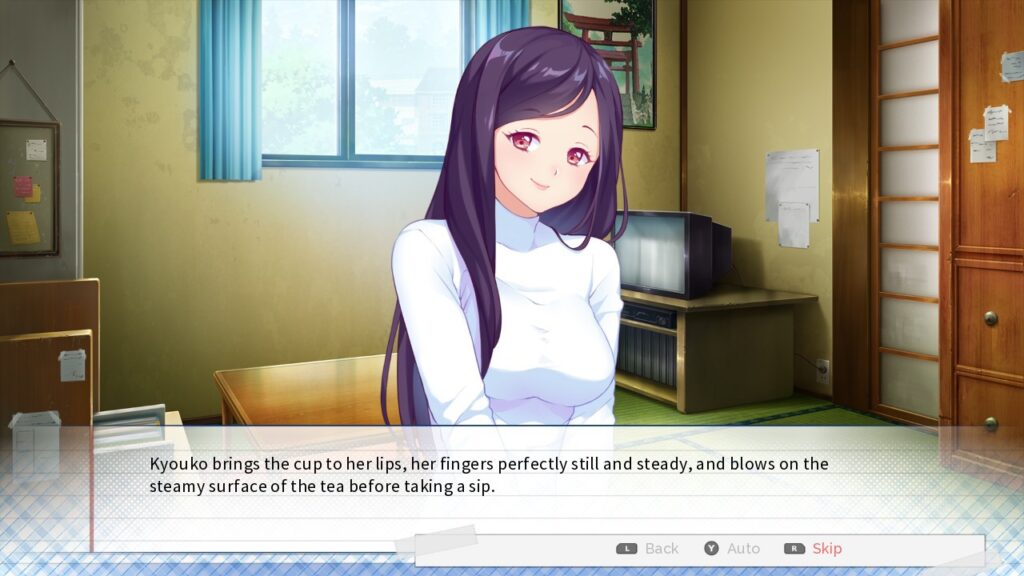
This review is based on a digital copy of The Language of Love provided by the publisher. It was played on a Nintendo Switch in both docked and undocked modes and was outstanding in both. The Language of Love is also available on PS4, Xbox One, and Windows on Steam. All screenshots are of actual gameplay.

